The 2020 college football season is officially in the books following Alabama’s 28-point thrashing of Ohio State in the College Football National Championship, which means it’s time for us to unveil the PFF College 101.
Below is a list of PFF’s top 101 players from this past college season. This ranking is based on various factors, including PFF grade and other advanced statistics available to PFF’s CFB Premium Stats+ Subscribers, and it does not incorporate positional value. On top of that, this has nothing to do with each player’s pro potential. We are looking solely at the top performers at each respective position.
Enjoy!
(Note: Some players may have leapfrogged others at their respective positions since we announced our All-American and All-Conference teams due to postseason performance)
-
WR DeVonta Smith, Alabama
Historic. Unprecedented. Elite. Unbelievable.
Those are all words that should be associated with what Devonta Smith did in the 2020 season. In addition to breaking the PFF College record for best single-season grade by a wide receiver (94.9), the Heisman Trophy winner and national champion had the most valuable season we have on record by a non-quarterback. The previous record was held by LSU cornerback Derek Stingley Jr. for his 2019 true freshman campaign when he generated 1.08 wins above average (WAA), but Smith topped it quite easily with 1.22 WAA this year.
Smith made up for his thin frame for doing pretty much everything at an extremely high level. From his release package to his ball skills to his route-running to his after-the-catch ability, Smith has it all. And, as Ohio State found out in the Natty, he was virtually impossible to cover. Shaun Wade attempted to cover Smith in press coverage on 13 different occasions, and he came away with eight yards per route run (four catches, 105 yards).
Bama has been fortunate enough to have some incredible wide receivers represent the school, from Amari Cooper to Jerry Jeudy, but none have ever had a year quite like Smith’s 2020.
-
QB Mac Jones, Alabama
It seemed almost impossible that we would ever see a quarterback break the PFF College record for the highest single-season PFF grade, a record set by Joe Burrow in his historically good 2019 season, especially in a season such as this one. But Mac Jones did just that.
The Alabama quarterback finished his 2020 campaign with an incredible 95.8 PFF grade, well above Burrow’s mark of 94.9. He may not have the strongest arm, and he wasn't one to bust off many explosive runs, but Jones' accuracy, decision-making, timing and processing were undeniable. His 65.3% accurate-pass rate on passes thrown beyond the line of scrimmage was the second-best in the country, and his negatively graded throw rate ranks first among every single college quarterback in the PFF College era (2014-present).
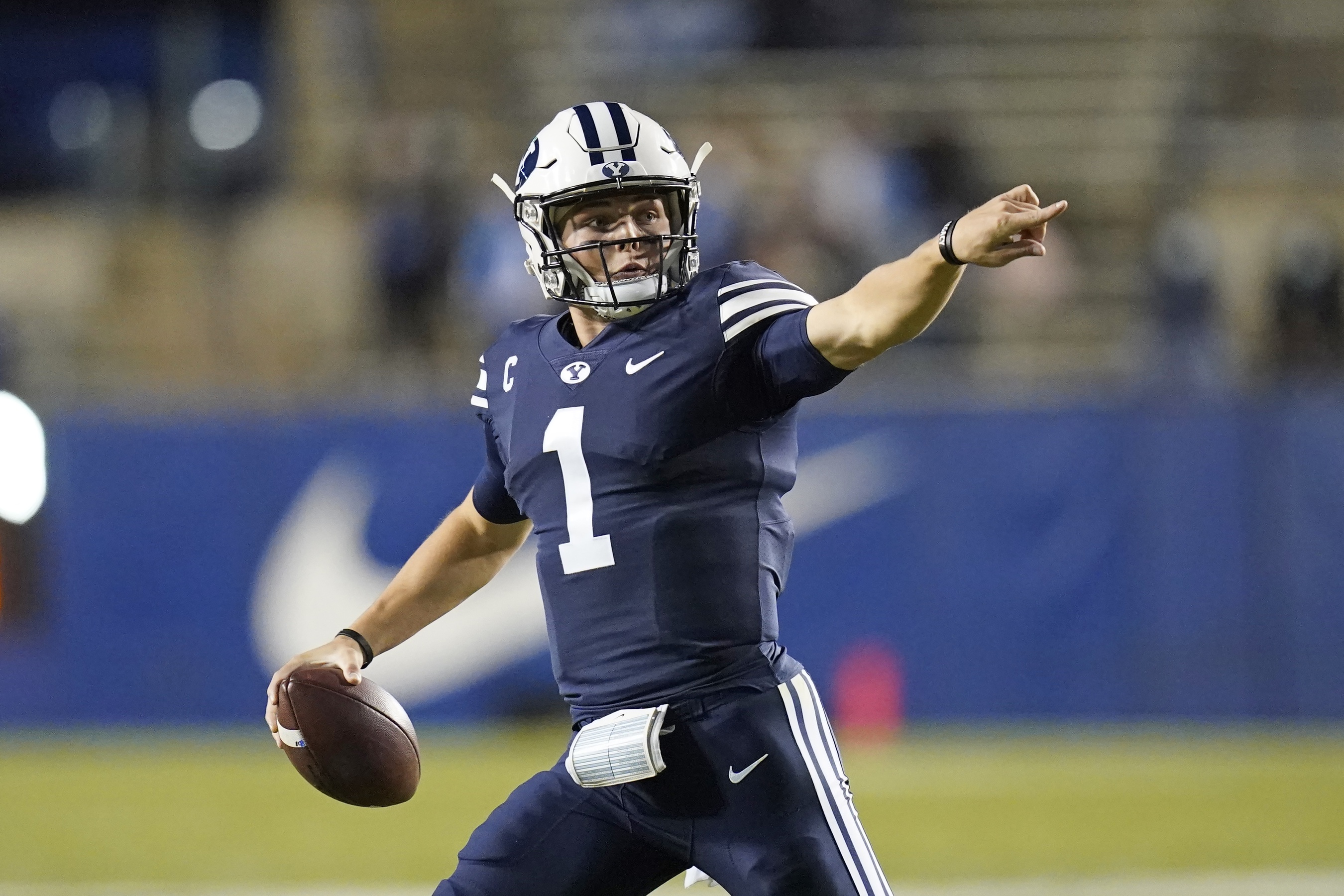
Oct 24, 2020; Provo, UT, USA; BYU quarterback Zach Wilson (1) looks downfield in the first half during an NCAA college football game against Texas State Saturday, Oct. 24, 2020, in Provo, Utah. Mandatory Credit: Rick Bowmer/Pool Photo-USA TODAY NETWORK -
QB Zach Wilson, BYU
Wilson may have faced a cupcake schedule, with zero Power 5 defenses faced, but the way he lit up the weak competition was unlike anything we have ever seen. The BYU quarterback recorded an elite passing grade above 90.0 in eight of his 12 games played this season, with his lowest-graded game sitting at 75.4. That gave Wilson a 95.5 passing grade for the season — the best by a non-Power 5 quarterback in 2020 by over three grading points and tops for a non-Power 5 passer since PFF College’s inception in 2014.
Wilson’s arm talent is truly special, and he can make off-platform throws look easy. No quarterback threw an accurate ball on a higher rate of their 20-plus-yard passes this season (73%). It’s up there with Joe Burrow for one of the biggest breakout seasons in recent memory.
-
TE Kyle Pitts, Florida
Pitts produced a record-breaking year at tight end this season. The versatile receiving weapon generated a 96.2 PFF grade this year, more than five grading points higher than any other tight end and well above the previous record set by former FAU Owl and now-Cleveland Brown Harrison Bryant in 2019 (92.5).
Pitts’ production was off the charts in 2020, regardless of where he was on the field. He averaged a colossal, position-leading 3.26 yards per route run. The Florida Gator played just shy of 64% of his offensive snaps inline, but he dominated unlike any other tight end we had ever seen when he lined up out wide in single coverage. Pitts went toe-to-toe with press coverage when lined up out wide for 40 receiving snaps this season and came away with seven explosive receptions of 15-plus yards on those opportunities. We have never seen a tight end record more than two of those in a single year before Pitts this season.
-
QB Justin Fields, Ohio State
Even with a couple of hiccups this season, Fields managed to produce the third-best PFF grade at the position (93.5). He got there with the help of his arm and his legs. Fields was the only quarterback in the country to rank in the top 10 in both passing and rushing grade; he showed off his downfield accuracy with the highest accurate-pass rate on passes thrown of 10 or more yards downfield (65%, nearly 10 percentage points higher than second) and racked up 17 runs of 10-plus yards on 63 carries (30 designed, 33 scrambles).
-
RB Javonte Williams, North Carolina
Williams had one of the most productive years we have ever seen at the position, and he came away with the highest rushing grade of the PFF College era (95.9). He averaged 0.48 broken tackles per rushing attempt in 2020, which is also a PFF College record, and he did so while leading all backs in the percentage of runs that picked up a gain of 10 or more yards (26.8%). The balance Williams possesses is extraordinary. Despite ranking 19th in the FBS in carries, Williams racked up four more runs that included 10 or more yards after contact than anyone in the country (23).
-
LB Zaven Collins, Tulsa
Collins did unprecedented things at the linebacker position this past fall and winter for the Tulsa Hurricane. His 93.7 grade in coverage is now well above the previous PFF record set by former UCLA Bruin and current Minnesota Viking Eric Kendricks all the way back in 2014 (92.1).
The 6-foot-4, 240-pound off-ball linebacker tallied four interceptions, three forced incompletions and nine passing stops when dropping into coverage. He was also one of the top blitz weapons in the entire country. All told, Collins picked up 16 pressures on 51 rushes and was the only player at his position to record a 90.0-plus grade in coverage and as a blitzer.
-
T Brady Christensen, BYU
Over the last seven years, no non-Power 5 tackle has ever dominated quite like Christensen did in 2020. The BYU product was the 12th-highest-graded tackle in the FBS in 2019 and jumped to No. 1 in 2020 with an astounding 96.0 PFF grade, over two full grading points higher than the previous non-Power 5 record.
Whether he was in pass protection or run blocking, Christensen rarely lost a rep. He earned a grade above 95.0 in each of those two facets, allowing only three pressures on 409 pass-block reps and a negatively graded run-block rate that cut the FBS average in half.
-
T Christian Darrisaw, Virginia Tech
Darrisaw didn’t quite break Penei Sewell's record for the highest single-season PFF grade by a Power 5 tackle (95.8), but he certainly challenged it, and he did so despite going against far stiffer competition. Darrisaw led all Power 5 tackles in both pass- and run-blocking grade this year, culminating in a 95.6 PFF overall grade for the season.
The Virginia Tech left tackle logged 293 pass-block snaps across 10 starts in 2020, yet he allowed just six pressures, all of which were hurries. He also notched the highest positively graded run-block rate in the Power 5 for his efforts as a people-mover in the Hokies' zone-rushing attack.
-
CB Patrick Surtain II, Alabama
Surtain was a true lockdown corner this season. He allowed just 0.53 yards per coverage snap on the outside, ranking seventh in the entire FBS. Given that he was put on an island more than anyone in the country this season and went up against the stiff competition of the SEC, that’s pretty good. Surtain allowed just 23 yards across 89 coverage snaps against Notre Dame and Ohio State in the College Football Playoff.
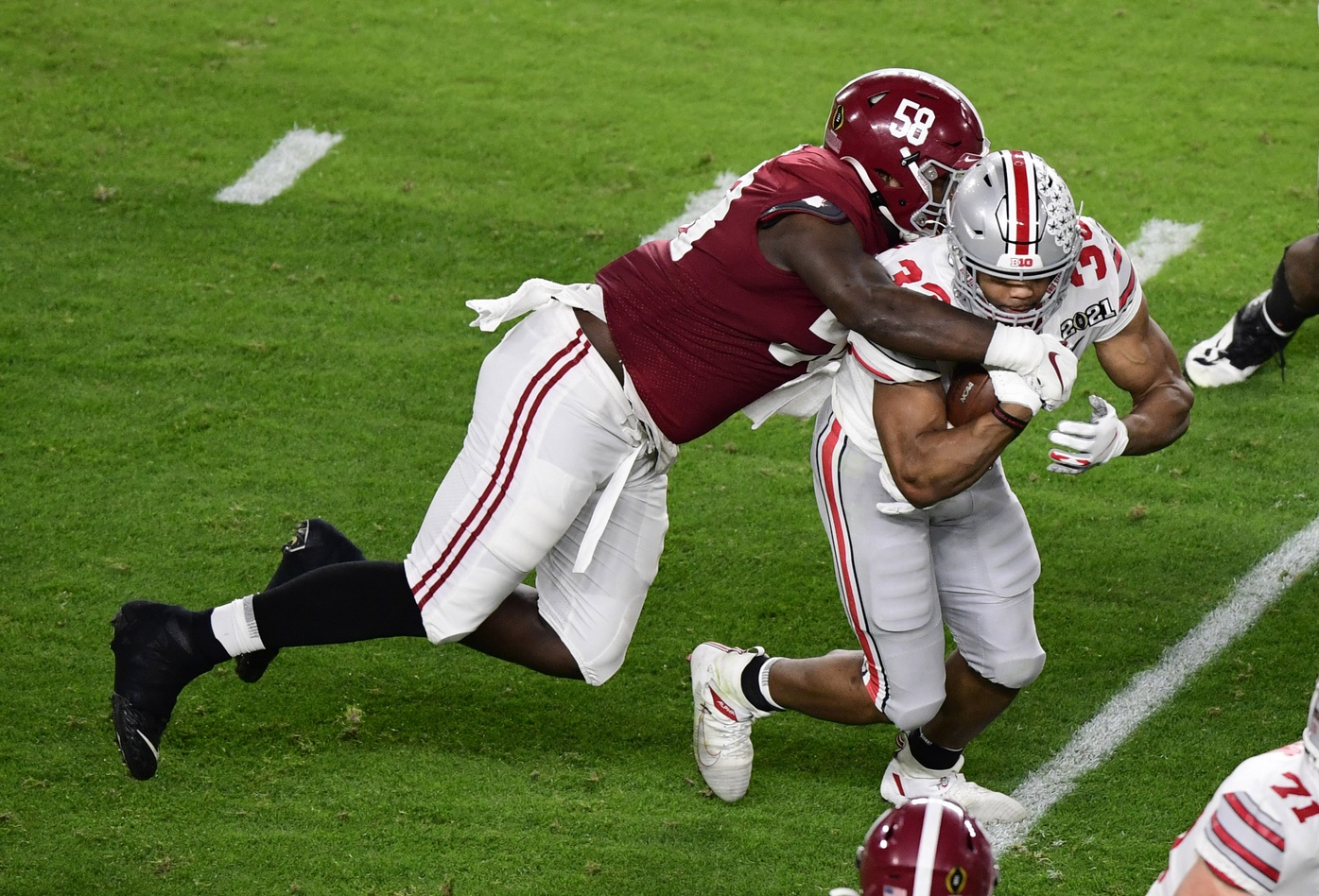
Jan 11, 2021; Miami Gardens, FL, USA; Ohio State Buckeyes running back Master Teague III (33) is tackled by Alabama Crimson Tide defensive lineman Christian Barmore (58) in the second quarter in the 2021 College Football Playoff National Championship Game at Hard Rock Stadium. Credit: Douglas DeFelice-USA TODAY Sports -
DI Christian Barmore, Alabama
Barmore showed hints of a possible Quinnen Williams-esque rise this year after dominating on a small sample in 2019. And while he got off to a good — albeit rather slow — start, the Crimson Tide interior defender caught fire down the stretch.
Barmore recorded a 91.3 pass-rush grade over his final two games of the season, which just so happened to come against the two best offensive lines in the country. He notched 12 pressures and won 23% of his pass-rush snaps over those last two contests and finished the season with the highest pass-rush grade among FBS interior defensive linemen (91.5).
-
C Tyler Linderbaum, Iowa
Two years ago, Linderbaum had just finished up his first season at Iowa as a defensive tackle. Now, he has just wrapped up a season in which he led all FBS centers in PFF grade, at 91.5. Yes, you read that correctly. He produced the best single-season grade we have given to a Power 5 center this season since former Arkansas Razorback and current Detroit Lion Frank Ragnow back in 2016. Linderbaum's physical tools are off the charts, and if he adds a bit more strength to his frame, he can really take his play to the next level.
-
EDGE Nik Bonitto, Oklahoma
Bonitto may have very well been the most underrated player, regardless of position, in all of college football this past season. He ranked first in pass-rush grade (93.5), pass-rush win rate (28.5%) and pressure rate generated (25.7%) among 257 qualifying FBS edge rushers this season, and there really wasn’t anyone close to him in any of those three metrics.
Bonitto’s explosiveness and athleticism caused headaches for every offensive tackle he faced, and there truly wasn’t a single lineman who was able to shut him down. His lowest win rate in a single game this year sat at 17.6% — for most FBS edge rushers, that’s a pretty good day.
-
CB Tre'Vius Hodges-Tomlinson, TCU
Many moons ago, TCU had a college football star at running back who ended up in the NFL Hall of Fame. That man was LaDainian Tomlinson. Now, his nephew, Tre’Vius Hodges-Tomlinson, looks like he might just join him in the pantheon of Horned Frog greats.
The 5-foot-9, 177-pound corner posted an 89.1 coverage grade in his first full year in a starting job. Not only did that lead the Big 12, but it led everyone in the FBS. Hodges-Tomlinson struggled in his season debut, allowing four catches for 69 yards and a touchdown, but he was almost flawless the rest of the way. He actually broke up more passes (14) than catches allowed (12) on 45 targets in the games after that debut.
-
QB Spencer Rattler, Oklahoma
Rattler earned a 92.5 passing grade in his first year as the Sooners' starter, tied for third in the entire FBS. Sure, there were some issues with his reads in the pocket, and we saw that on game-sealing interceptions against Kansas State and Iowa State, but don’t let a couple of throws cloud your judgment.
Rattler has a beautiful release, and his blend of arm talent and accuracy is nothing short of amazing. He made several ridiculous throws on the run and came first by a significant margin in PFF passing grade when outside of the pocket. And let’s not forget that his receiving unit didn’t help matters, as Rattler had seven big-time throws that were dropped this season, the most any college quarterback has had to endure in a season since 2014.
-
CB Shemar Jean-Charles, App State
Jean-Charles is right there with Oklahoma’s Nik Bonitto as one of the most underappreciated players in college football. He plays the catch point as well as anyone in the game and has pinpoint timing and location. That elite trait helped Jean-Charles record a higher forced incompletion rate (34.6%) than catch rate allowed (32.7%) this season.
Jean-Charles saw 35 targets in single coverage this season and allowed only five catches while forcing 18 incompletions. He may not be a Power 5 corner, but there is no doubt he is just as good as the cream of the crop from the bluebloods.
-
QB Sam Howell, North Carolina
To no surprise, Howell finished the 2020 season as one of the best deep passers in college football, ranking fourth in the FBS in passing grade on passes thrown 20-plus yards downfield and first in deep big-time throws (30).
Howell was also one of the top deep passers as a true freshman in 2019, but we needed to see him tighten up his decision-making and limit the plays where he tries to do too much under duress. The sophomore Tar Heel certainly did that, as he cut his turnover-worthy play rate from 3.5% in 2019 (56th) to 2.2% in 2020 (eighth).
-
WR Elijah Moore, Ole Miss
Moore exploited the holes in zone coverage with regularity in Lane Kiffin’s offense at Ole Miss. In fact, no FBS receiver generated more explosive plays of 15-plus yards through finding a hole in zone (12) in 2020. Altogether, Moore racked up the second-most yards per route run in the Power Five (3.87) against zone looks.
Moore didn't see much single coverage as a primary slot receiver, but he looked drastically improved this season when he did. He won a number of his downfield routes on those plays and ranked ninth in the FBS in receiving grade against single coverage for the year.
-
C Landon Dickerson, Alabama
Dickerson was the clear-cut second-best center in college football behind Linderbaum, joining the Iowa center as the only players at the position to earn a PFF grade north of 90.0 for the season.
Dickerson’s 91.3 PFF grade tied for the second-best by an SEC center since 2014. The Crimson Tide center’s pass-protection was strong, but his impact in the run game is what catapulted him up this list. He led all FBS centers in positively graded run-block rate and came in second when it came to negatively graded run-block rate.
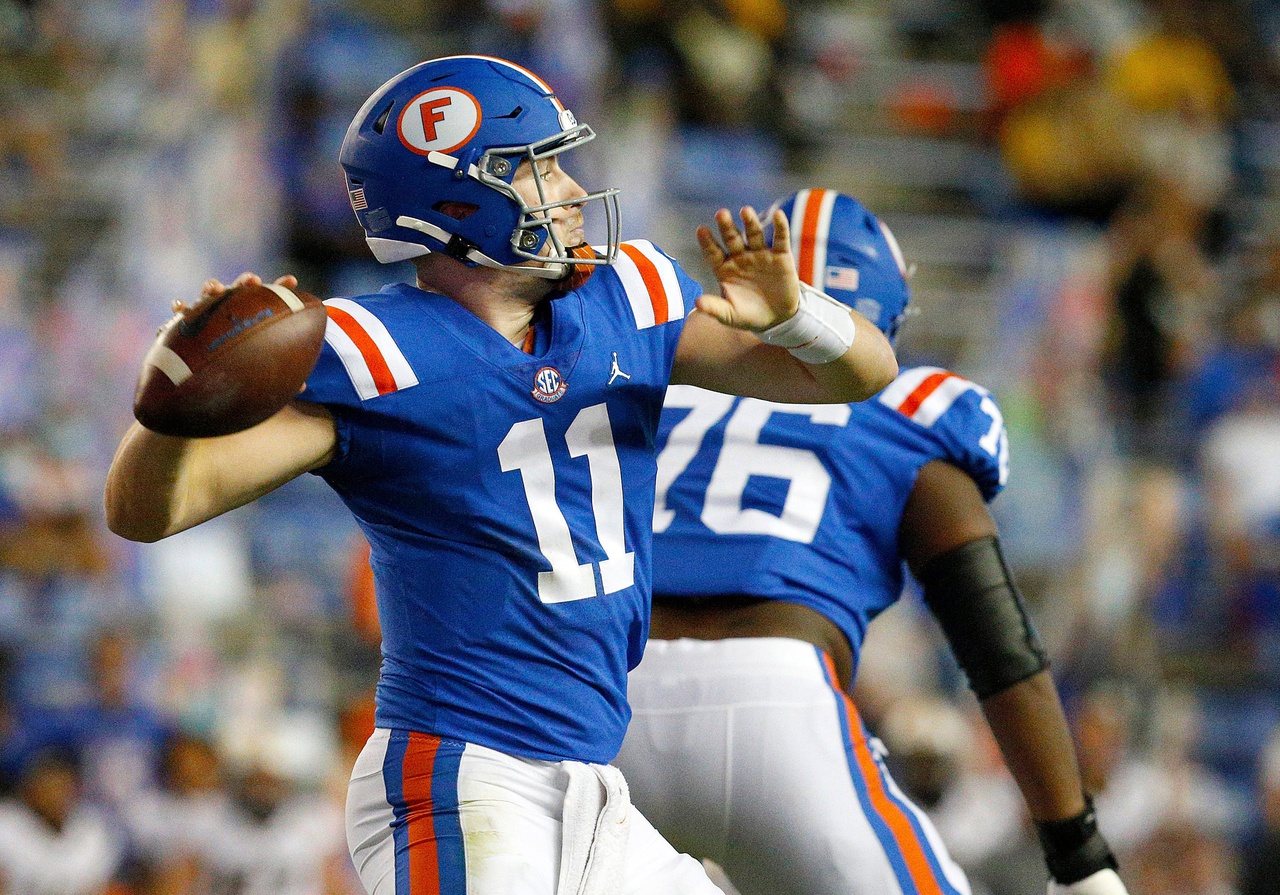
Oct 31, 2020; Gainesville, FL, USA; Florida quarterback Kyle Trask (11) throws a pass during a game against the Missouri Tigers at Ben Hill Griffin Stadium. Credit: Brad McClenny-USA TODAY NETWORK -
QB Kyle Trask, Florida
Trask had one of the best year-to-year improvements we have seen at the quarterback position this past season. In 2019, Trask posted a 66.4 passing grade and tied for the fourth-worst big-time throw to turnover-worthy play ratio in the entire country (9:22). This year, Trask improved his passing grade to an elite mark of 92.4 and had the best big-time throw to turnover-worthy play ratio in the country (41:13).
-
EDGE Rashad Weaver, Pitt
Weaver finished his season with a 90.0 pass-rush grade and produced multiple pressures in every single game played. And he did this despite facing some extremely stiff competition in the ACC. The Pitt edge defender racked up 20 total pressures in his games against Notre Dame, Clemson, Virginia Tech and Boston College — the four best sets of tackles in the ACC this year.
-
QB Trevor Lawrence, Clemson
Lawrence became the only quarterback of the PFF College era to record a single-season grade north of 90.0 as a true freshman, sophomore and junior after posting a 91.2 mark this season. We saw that cannon of an arm on numerous occasions this season, and the bouts of inaccuracy that hindered him in the past were nowhere to be found. Lawrence was third in the country this season in percentage of accurate passes thrown beyond 10 yards downfield (56.4%).
Again, this list has nothing to do with pro potential. Lawrence may be No. 22 here based solely on his performance this past season, but he is easily locked into the top spot on our 2021 big board.
-
QB Grayson McCall, Coastal Carolina
Coastal Carolina’s triple-option offense was lifted by QB Grayson McCall and his ability to carve defenses up through the air. McCall finished the season with the seventh-best big-time throw rate and fifth-lowest uncatchable-pass rate on throws beyond the line of scrimmage. He ultimately tied with Spencer Rattler for the nation's third-best passing grade at 92.5.
-
S Tykee Smith, West Virginia
Smith was one of the best slot defenders in college football, serving as the “spear” in the West Virginia defense. Among all FBS defensive backs with at least 100 snaps in the slot, Smith comes in at No. 1 in coverage grade. Smith saw at least three targets in all nine of his starts, yet he managed to allow under 30 yards in every single one of his games this year.
-
CB Eli Ricks, LSU
Ricks was one of Ed Orgeron’s blue-chip recruits from the 2020 class and somehow managed to surpass his already lofty expectations. The five-star true freshman was tasked with playing a lot of single coverage in LSU’s defense, and he looked like a seasoned vet. Ricks posted the highest coverage grade in the Power 5 when in single coverage and allowed only six catches on 19 such targets while intercepting three and forcing four others to fall incomplete.
-
WR Jaelon Darden, North Texas
Darden finished the season as the fourth-highest-graded wide receiver in all of college football. The 5-foot-9, 174-pound wide receiver has been among the most elusive in the game, breaking an FBS-high 23 tackles en route to averaging 7.7 yards after the catch per reception. Darden was clearly a threat on screens, but he was even more so on vertical routes with his deep speed. His receiving grade on such routes ranked fourth in the FBS, and his 11 receiving touchdowns are two more than anyone else.
-
RB Michael Carter, North Carolina
North Carolina fielded one of the best backfields in the history of college football this season with Williams and Michael Carter. The two ranked first and second in the FBS in the percentage of runs that resulted in a 10-plus-yard gain — at 26.8% and 26.1%, respectively — with both figures nearly doubling the FBS average. While Williams had the best season we have seen from a pure rushing standpoint, Carter had one of the best years for a dual-threat back, cracking the top six in the FBS in both rushing and receiving grade this year.
-
G Cain Madden, Marshall
Madden was the top guard in college football this season, and it wasn’t particularly close. His 92.5 PFF grade was the best at the position by two full grading points, and he allowed only six hurries — and didn’t give up a single sack or hit — across 273 pass-block snaps. The Marshall product also posted the lowest negatively graded run-block rate among all FBS guards, leading to a 93.0 grade in that facet.
-
RB Najee Harris, Alabama
Along with UNC’s Michael Carter, Alabama’s Najee Harris was one of the game's best dual-threat backs. He broke 22 tackles on 43 catches as a receiver, nine more missed tackles forced than any other back in the country. As a runner, Harris racked up 54 runs that included at least five yards after contact, the most at the position by eight.
-
T Thayer Munford, Ohio State
Munford is one of the biggest risers on this entire list. While he was good in 2019 — his second season starting at left tackle — earning a 76.9 PFF grade, Munford was flat-out elite in 2020.
There wasn’t a bad game to speak of for the Buckeyes tackle, as he allowed just three pressures (all hurries) in seven games and recorded a 90.3 grade in the run game. Overall, Munford posted a 91.8 PFF grade that stands as the fourth-best grade we have ever given to a Big Ten tackle, behind only Jack Conklin (2015), Ryan Ramczyk (2016) and Tristan Wirfs (2019). That's not bad company to be in.
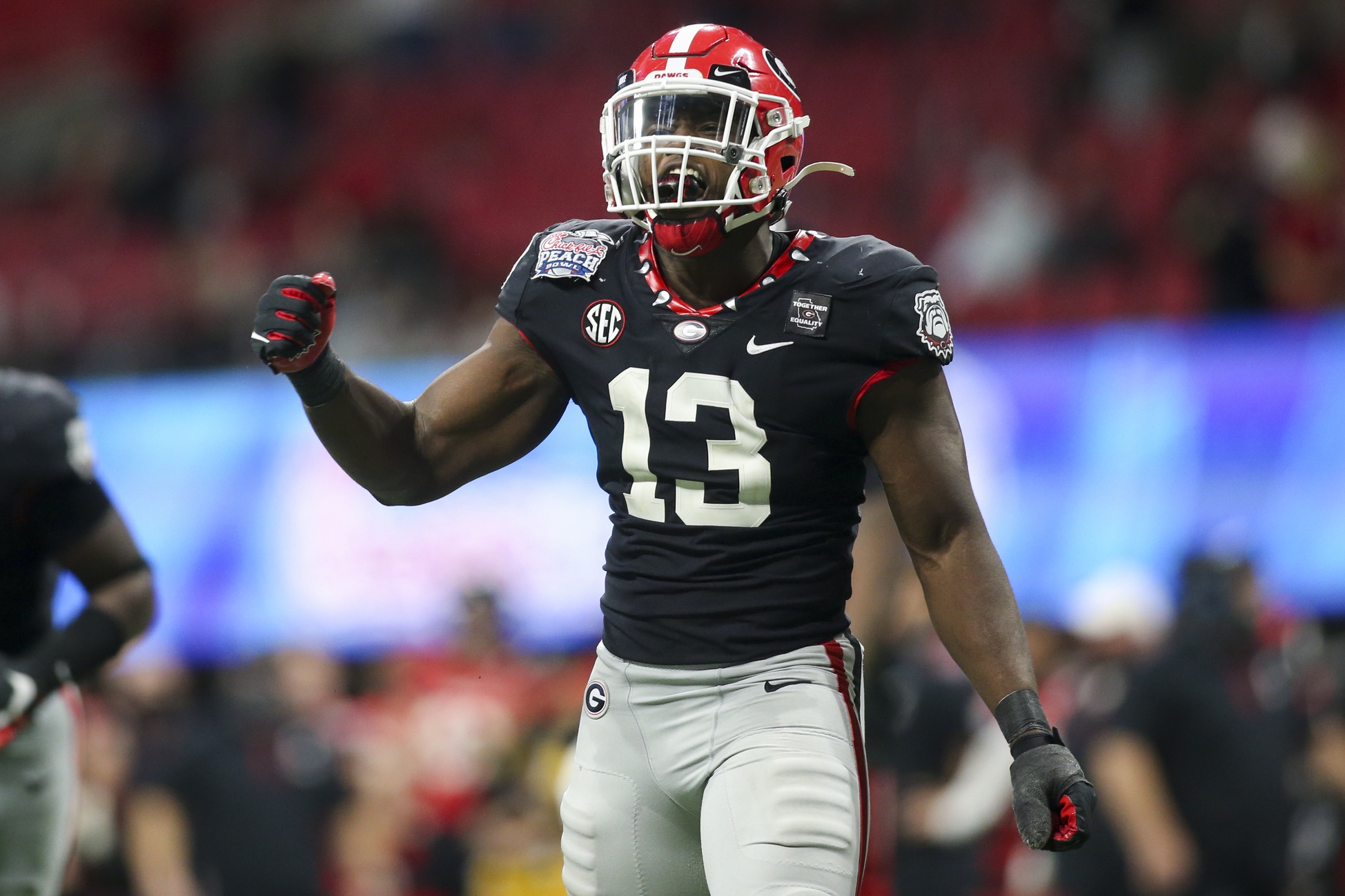
Jan 1, 2021; Atlanta, GA, USA; Georgia Bulldogs linebacker Azeez Ojulari (13) celebrates after a sack against the Cincinnati Bearcats in the second half of the Chick-fil-A Peach Bowl at Mercedes-Benz Stadium. Credit: Brett Davis-USA TODAY Sports -
EDGE Azeez Ojulari, Georgia
Explosive pass-rusher Azeez Ojulari broke out in a big way in 2020, raising his 71.4 pass-rushing grade in 2019 to 91.7 this past season to rank second in the FBS. Ojulari forced three strip-sack fumbles and generated a 24.3% pass-rush win rate, a top-five figure in the FBS. That’s pretty impressive for a guy who had to go up against an SEC tackle in nine of his 10 games played this year.
-
CB Elijah Molden, Washington
Molden was unequivocally the best slot corner of the 2019 season, displaying tremendous short-area quickness, ball skills and more physicality than you’d expect. And despite playing in only four games this year, he was once again one of the best defensive backs in college football. He still managed to put together the fourth-best slot coverage grade in the Power Five in those four games while recording seven passing stops, an interception, two forced incompletions and just 65 total yards allowed in coverage.
-
T Samuel Cosmi, Texas
Cosmi was excellent in his first two years starting at tackle for the Longhorns in 2018 and 2019, earning PFF grades of 79.7 and 83.9. This year, he took his play to elite status, earning a 90.5 PFF grade in the process. Cosmi was the sixth-highest-graded tackle in the entire FBS on true pass sets (i.e., no play-action, screen, rollout, RPO, quick throw, three-man rush) this year.
-
DI Alim McNeil, NC State
McNeil played 87% of his total snaps at heads-up nose tackle this year, making his production nothing short of incredible. Only one player since 2014 has produced a higher PFF grade at 0-technique than McNeil’s 90.5 mark this season (former Mississippi State Bulldog and current Tennessee Titan Jeffery Simmons in 2017). McNeil won 10% of his pass-rush snaps at nose tackle, an impressive figure in its own right, but his success was largely in run defense. He was a constant disruptor en route to a 92.1 run-defense grade on the year.
-
EDGE Raymond Johnson III, Georgia Southern
Johnson has been an impact player along Georgia Southern’s defensive line since he first stepped foot on the field for the program as a freshman in 2017, and his 2020 campaign was his best season yet. The defensive end owned the highest PFF grade at his position in the entire FBS (91.9). Johnson was also the only player to see at least 100 snaps against the run and as a pass-rusher while recording a grade above 85.0 in each facet. And he easily accomplished that, earning grades above 89.0 in both areas.
-
T Liam Eichenberg, Notre Dame
Notre Dame may have fallen short in the College Football Playoff semifinal, but Eichenberg performed better than any tackle has against Alabama's ferocious defensive front this season, generating an 87.9 PFF grade for the game. That wasn't much different from what Eichenberg did all year long. He finished as the sixth-most valuable tackle in the FBS and earned a fringe-elite PFF grade of 89.9.
-
DI Haskell Garrett, Ohio State
Garrett, a 2017 four-star recruit, finally took on a starting job this year. The results were everything Ohio State coaches and fans could have dreamed of. Despite a lowly performance against Alabama in the 2021 National Championship game, Garrett’s 88.9 pass-rush grade trailed only Alabama's Christan Barmore among Power Five interior defensive linemen this season. That mark is also over seven grading points better than third place.
-
LB Jeremiah Owusu-Koramoah, Notre Dame
Owusu-Koramoah was a game-changer serving as the rover in the Fighting Irish defense. He shined in every single facet of play, but especially so in coverage. In that role, Owusu-Koramoah predominantly manned the slot, from which he earned the third-highest coverage grade in the FBS. He allowed only five first downs across 200 slot coverage snaps in 2020 with an interception, four forced incompletions and four passing stops.
-
CB Zech McPhearson, Texas Tech
McPhearson opened up the season with a poor performance against Houston Baptist, but he righted the ship and performed exceptionally well in every game after that. He played a good amount in the slot (107 coverage snaps) and on the outside (232 coverage snaps), but Texas Tech got the best out of him when he was on the outside. There, McPhearson ranked fourth in the FBS in coverage grade and seventh in first downs/touchdowns allowed per coverage snap. He allowed only six of those plays on the outside while intercepting four passes, forcing three incompletions and recording seven passing stops.
-
T Teven Jenkins, Oklahoma State
Jenkins was a bulldozer in the run game for the Pokes this season. His 93.6 run-block grade came in at No. 3 among all FBS tackles and is the seventh-best mark we have recorded in the PFF College era at the position. He also held his own in pass protection with just four pressures allowed across 211 pass-block snaps.
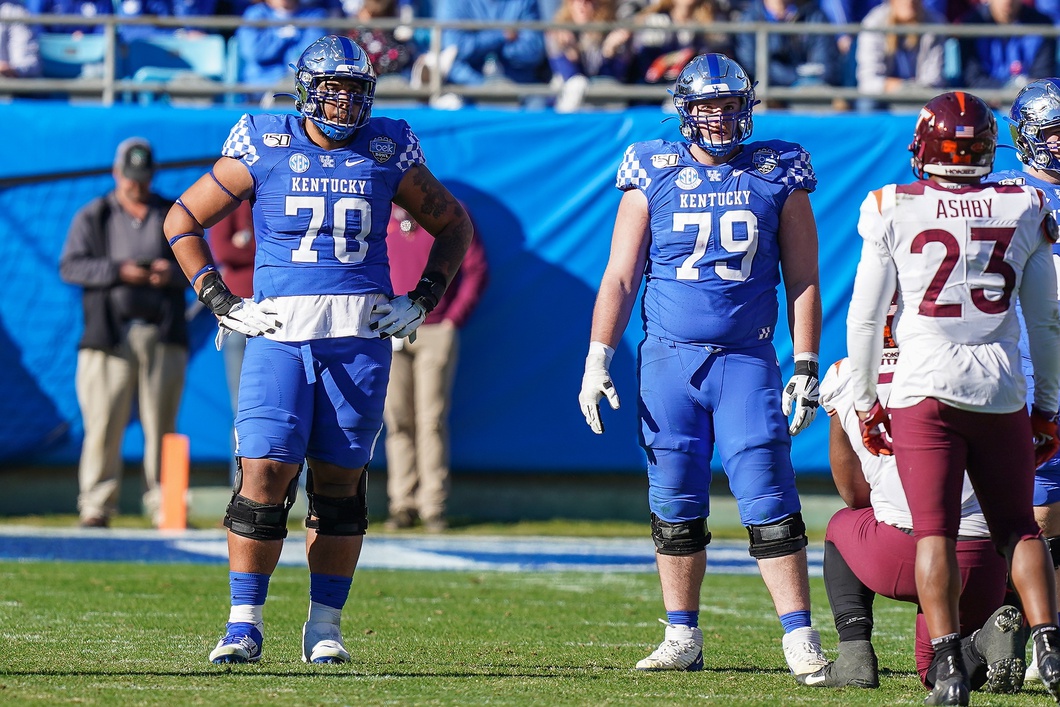
Dec 31, 2019; Charlotte, North Carolina, USA; Kentucky Wildcats offensive lineman Darian Kinnard (70) and offensive tackle Luke Fortner (79) during the second half against the Virginia Tech Hokies of the Belk Bowl at Bank of America Stadium. Credit: Jim Dedmon-USA TODAY Sports -
T Darian Kinnard, Kentucky
Right after Jenkins, the top run-blocking right tackle was Kentucky’s Darian Kinnard. This isn’t much of a surprise, as he posted an 89.1 grade in that facet in 2019. In 2020, Kinnard topped his impressive 2019 campaign with a 91.9 grade as a run-blocker. The 6-foot-5, 345-pound tackle has numerous manhandling reps in the run game this season, even when he went up against Alabama and Georgia.
-
LB Kadofi Wright, Buffalo
Despite a shortened season, Wright managed to be one of the most productive off-ball linebackers in the country when dropping into coverage. He saw 16 targets on the year and allowed only three to be caught (just one being a first down) while intercepting one and forcing six incompletions. That led to a 90.4 coverage grade on the year. The Buffalo Bull also brought value as a pass-rusher, with nine pressures on 21 rushes, and against the run, with a 78.4 grade.
-
S Jaquan Brisker, Penn State
Brisker went from Lackawanna Community College to first-team PFF All-American in just two years. No FBS safety recorded a better PFF grade while in the box, and Brisker quite easily displayed the best tackling ability of any player at the position, missing just one of his 60 tackle attempts on the year. That success, combined with his performance against the run in the box and his playmaking in coverage (seven plays on the ball, five passing stops), led Brisker to a Power Five-best 85.6 PFF grade.
-
WR Kadarius Toney, Florida
Toney moves in a way that is almost hard to believe. His combination of balance, agility and explosiveness makes him nearly impossible to tackle. The Florida wideout touched the ball 89 times this past season and broke 27 tackles. Of his 70 receptions, Toney racked up at least 10 yards after the catch on 20 of them (fourth-most in the entire FBS).
-
CB Shakur Brown, Michigan State
Brown began the year in the slot before moving to the outside two games into the season. Regardless of where he lined up, he made plays. Along with having the eigth-best coverage grade in the FBS (84.2), Brown tied for the most interceptions among Power Five cornerbacks (five). That led to a 52.4 passer rating allowed in coverage.
-
WR Dax Milne, BYU
Milne — a former walk-on — was a big-time breakout in 2020 alongside quarterback Zach Wilson. The wide receiver raised his PFF grade by nearly 30 points in 2020 to 90.0. He was a big-play threat at Wilson’s disposal and teamed up with him for 30 receptions of 15-plus yards, trailing only Alabama's Devonta Smith for the most in college football.
-
EDGE Jordan Smith, UAB
With his power and length, Smith has been a constant force in every single game he has played for UAB. A former four-star recruit, he came to the Blazers in 2019 after spending time at Florida and Butler Community College. The 6-foot-7, 255-pound edge rusher put up a 91.5 pass-rush grade in 2019 and nearly matched it in 2020 with a 91.4 mark (third in the FBS). Smith won on 26.4% of his pass rushes, trailing only Oklahoma's Nik Bonitto for the best rate in the country.
-
QB D'Eriq King, Miami (FL)
King was everything The U had hoped for: An elite dual-threat. He made numerous plays both through the air and on the ground in his first season with the Hurricanes, resulting in a 90.6 PFF grade for the season (10th in the FBS). On 111 runs (85 designed, 26 scrambles), Kind totaled 26 runs of 10 or more yards. He produced more than 10 yards after contact on thirteen of those, the most at the position. As a passer, King hardly put the ball in harm’s way. He consistently made the right decision and came in at No. 3 in the FBS in turnover-worthy play rate (1.7%).
-
LB Nick Anderson, Tulane
Anderson was among the Group of Five secret superstars this season. He finished the year as one of the five most valuable players at his position and posted an 88.1 PFF grade. The Green Wave linebacker was effective in every facet, but the bulk of his success came against the run. Anderson tied for the highest run-defense grade among off-ball linebackers (91.6).
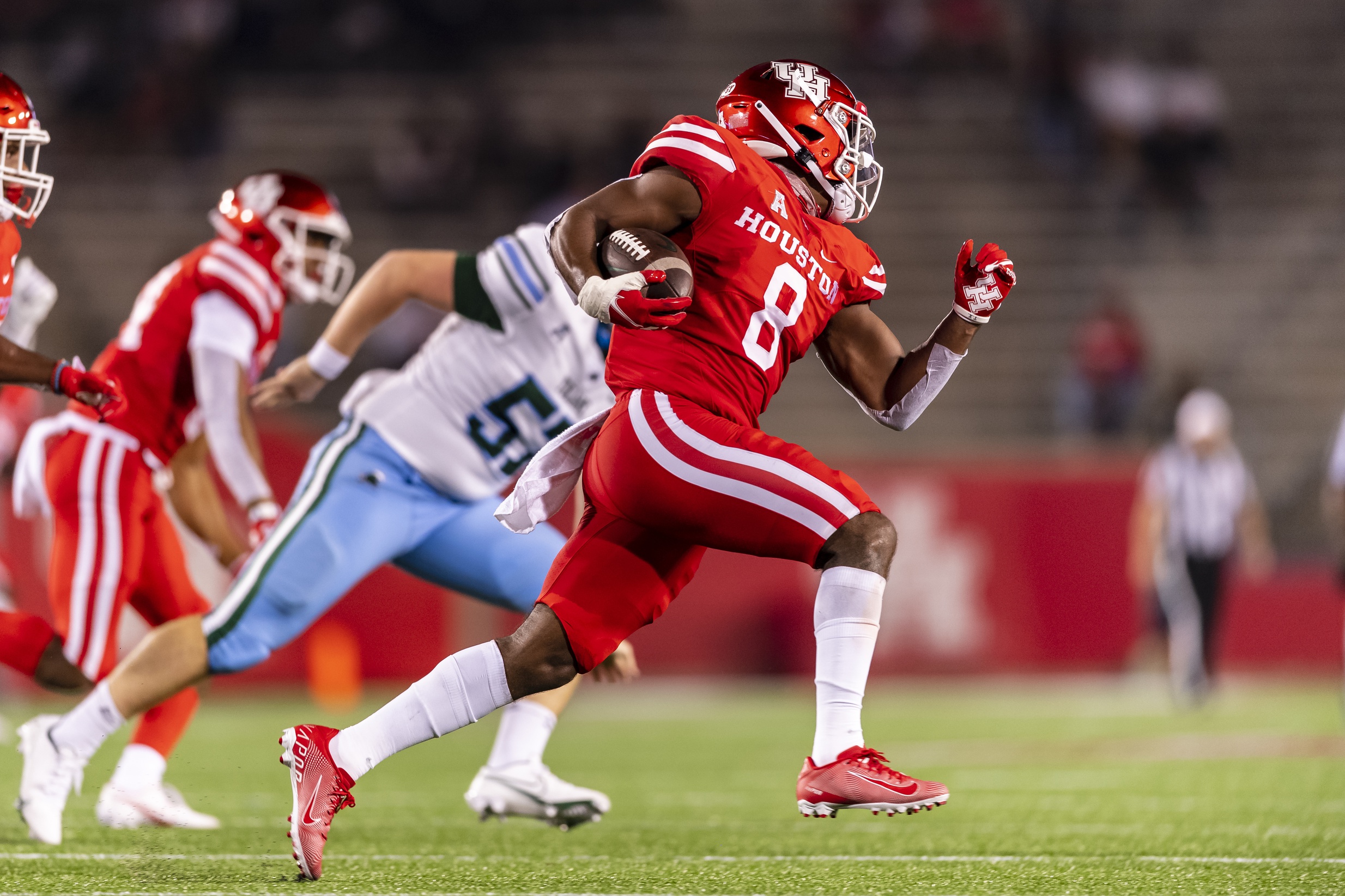
Oct 8, 2020; Houston, Texas, USA; Houston Cougars cornerback Marcus Jones (8) runs the kickoff return during the second quarter at TDECU Stadium. Credit: Maria Lysaker-USA TODAY Sports -
CB Marcus Jones, Houston
Jones had to sit out the 2019 campaign after transferring to Houston from Troy, but this year he looked like the same great Group of Five corner we saw when he was with the Trojans in 2017 and 2018. In those seasons, Jones recorded 72.9 and 82.0 coverage grades, respectively. That figure spiked to 88.9 in 2020. He was sticky in single coverage, with just three catches allowed on 17 such targets, and made nine passing stops while constantly blowing plays up underneath.
-
CB Josh Jobe, Alabama
Jobe formed college football’s clear-cut best cornerback duo with Patrick Surtain II and is on the path to becoming one of the several great defensive backs to come from the University of Alabama. In his first full season starting for the Crimson Tide, Jobe rarely gave up big plays. He ranked second in college football in yards per coverage snap allowed on the outside (0.42) and looked as good as Surtain when it came to press coverage.
-
CB Greg Newsome II, Northwestern
Newsome was one of the Big Ten’s biggest breakouts this season. After producing poor, sub-60.0 coverage grades in his first two years on campus in 2018 and 2019, Newsome posted the seventh-best coverage grade in the Power Five in 2020 (83.8). He allowed only 93 yards and five first downs on 223 coverage snaps while making eight total plays on the ball.
-
S Keith Gallmon, South Alabama
Whether he was down in the box, trying to stop the run or roaming over the middle of the field at deep safety, Gallmon made play after play for the Jaguars this season. The 5-foot-9, 205-pound safety was the only player at his position in the FBS with a grade above 80.0 in both coverage and run defense.
-
EDGE Jaelan Phillips, Miami (FL)
Everyone was excited to watch Gregory Rousseau and Quincy Roche form one of the best pass-rush tandems in college football in 2020, but Rousseau elected to opt out before the season started. This opened the door for UCLA transfer Phillips to see substantial action, and surprisingly, he helped give Miami that top pass-rushing duo we all thought we were going to see with Rousseau and Roche.
Phillips had a bit of a breakout game in his fourth outing of 2020 when he generated six pressures against Clemson, and he managed to sustain that success for the rest of his season. He ranked fifth in the FBS in PFF grade and eighth in pressures generated since Miami's contest with the Tigers.
-
LB Jon Rhattigan, Army
Senior linebacker Jon Rhattigan had played just 21 snaps on the defensive side of the ball in his career prior to 2020, but he earned a starting role this season and performed incredibly well. Rhattigan closed out the year ranking fifth among FBS off-ball linebackers in PFF grade (86.6) and was one of eight at the position to earn a grade above 70.0 against the run, in coverage, as a pass-rusher and in tackling.
-
T Robert Hainsey, Notre Dame
Hainsey bounced back in a big way this year from a 2019 season-ending ankle injury. The beefier lines of Pittsburgh and Alabama gave him some fits, but we have few bones to pick with how Hainsey performed from start to finish. He earned an 89.6 PFF grade this season that ranked sixth among all FBS right tackles, and he was one of three Power Five players to earn grades above 80.0 as both a pass-blocker and a run-blocker.
-
C Drake Jackson, Kentucky
Jackson’s pass protection was almost as clean as a whistle. He allowed just three pressures across 305 pass-block snaps, none of which were a sack or a quarterback hit. Kentucky’s run game is predicated on inside zone, and Jackson was in his element on those plays. His run-block grade on inside zone runs was the best in the FBS by over eight grading points.
-
WR Jaquarii Roberson, Wake Forest
Roberson came into the season with 29 targets in three years at Wake Forest and has left it the second-highest-graded wide receiver in the FBS (92.4) — just like we all expected. Whether it was against single coverage or from finding a soft spot in zone, Roberson was constantly getting open, mostly via the latter. He collected 39 first downs and touchdowns combined when he had a step or more of separation on his nearest coverage defender, the eighth-most in the FBS.
-
S Brandon Joseph, Northwestern
Like his teammate Greg Newsome II, safety Brandon Joseph was an unexpected big-time breakout. He took a redshirt in his first year on campus as a three-star recruit in 2019 and was the second-highest-graded safety in college football this season. Joseph allowed just two first downs in coverage while racking up six interceptions and five other passing stops.
-
EDGE Cameron Sample, Tulane
Sample transitioned from standard defensive end to stand-up outside linebacker and took his pass-rushing skills to new heights. His 69.1 pass-rush grade from 2019 improved to an elite 90.4 mark in 2020. Sample’s run defense was no issue in 2019, and that remained true in 2020, as he posted an 84.0 grade in that facet. That led him to an 89.9 PFF grade for the season, ranking fifth in the FBS.
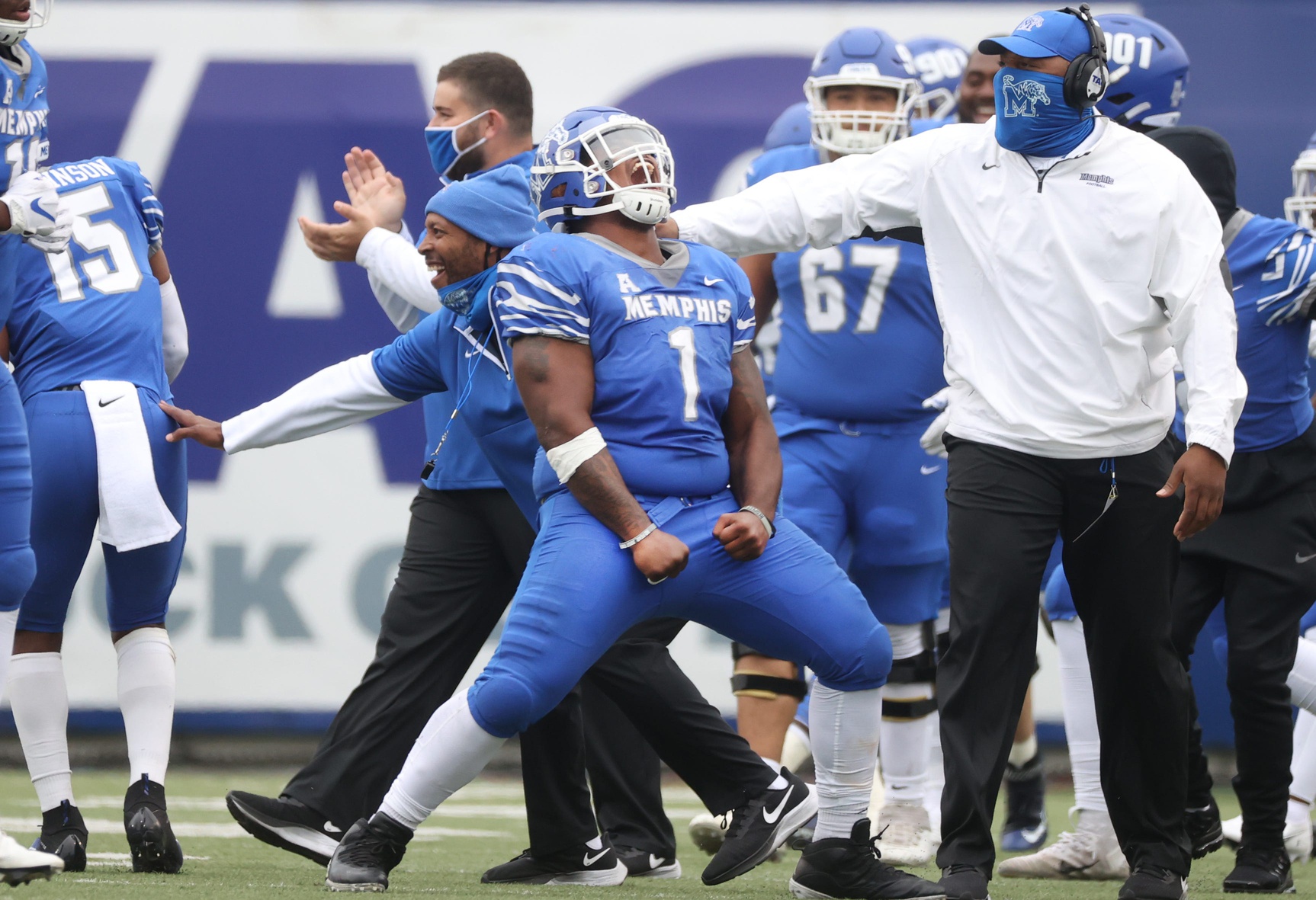
Memphis Tigers' O'Bryan Goodson celebrates his strip and recovery against the Temple Owls at Liberty Bowl Memorial Stadium. Credit: Imagn -
DI O'Bryan Goodson, Memphis
Goodson played the fifth-most snaps in college football at heads-up nose tackle this season and was among the most productive. The 6-foot-1, 297-pound Memphis Tiger was the only player to earn grades above 80.0 both against the run and as a pass-rusher when playing 0-technique. And he did that quite easily — posting marks above 88.0 in each en route to a 90.5 PFF grade at the alignment.
-
QB Matt Corral, Ole Miss
Despite one of the worst games we saw at the position this season back in Week 7 against Arkansas, featuring six interceptions and a 30.8 passing grade, Corral still finished the season with a 90.4 PFF grade. That was good enough to rank ninth in the FBS. In Lane Kiffin’s quarterback-friendly offense, Corral racked up the fifth-most deep passing yards (1,265). Even with that six-interception performance, he still managed to rank in the top 20 in the FBS when it came to negatively graded throw rate. He paired that with the 11th-best positively graded throw rate, making him one of six Power Five quarterbacks to rank in the top 20 in both categories (Mac Jones, Justin Fields, Spencer Rattler, Sam Howell and Kyle Trask).
-
WR Tylan Wallace, Oklahoma State
Wallace was a go-route savant for Oklahoma State this season and helped create some massive plays for an offense that had middling quarterback play in 2020. No wide receiver caught more go balls this year than Wallace (11), and only one other wideout topped his receiving grade on such routes. His vertical route prowess and routine dominance in contested scenarios helped him earn an 86.3 receiving grade for the season.
-
CB Martin Emerson, Mississippi State
Emerson showed off some of the best zone coverage play in the country this season. He was quick to react to the quarterback and ended up tying for third among FBS outside corners in total forced incompletions (seven) and passing stops (nine) when in zone. And he did all of that while allowing just six first downs on such plays.
-
CB Rodarius Williams, Oklahoma State
Rodarius Williams — the brother of Cleveland Browns cornerback Greedy Williams — was a good corner in his first three years starting for the Pokes from 2017 to 2019. This year, however, Williams was a lot more than just good; he locked down his side of the field. In nine games this season, Williams allowed just 10 catches in coverage and surrendered fewer than 10 yards in six outings. When lined up on the outside, Williams ranked second in the FBS in forced incompletion rate (35%) and fourth in coverage snaps played per catch allowed (24.0).
-
WR Marlon Williams, UCF
Williams was having a monstrous season for the Knights before leaving the team to focus on the 2021 NFL Draft following a Week 12 loss to Cincinnati. He was one of a few receivers to haul in a 15-plus-yard reception in every game played this year, and he still managed to rank third among slot receivers this year in that category despite the early opt-out (22). Williams was also one of the most difficult slot receivers to bring down, racking up an FBS-high 22 broken tackles in the slot.
-
C Creed Humphrey, Oklahoma
Few interior defensive linemen were able to pull off a severe win against Humphrey this season. The Oklahoma center didn’t allow a single sack or hit on over 400 pass-block snaps, and he also recorded the lowest negatively graded run-block rate by a country mile. One of the biggest things we wanted to see from Humphrey this year was the limitation of inaccurate snaps. That was a big issue in 2019, and Humphrey did cut the total number of bad snaps in half. There’s still some room for improvement in that regard, but it wasn’t tanking his grade like in 2019.
-
G AARON BANKS, NOTRE DAME
Banks closed out his season with a hiccup against Christian Barmore and the monstrous Alabama defensive front, but he still remained one of two Power 5 guards to produce a grade above 80.0 as both a pass- and run-blocker this season. The Notre Dame left guard actually generated more WAA than any other guard in the FBS this season.
-
LB Micah McFadden, Indiana
McFadden was one of college football’s top blitz weapons in 2019, and head coach Tom Allen and defensive coordinator Kane Wommack (who recently accepted the South Alabama head coaching job) made sure to use that to their advantage this season. Whether it was a traditional or replace blitz, McFadden rushed the passer 117 times and picked up 29 pressures, along with the highest pass-rush grade among off-ball linebackers with at least 50 rushes (91.2). McFadden also notched a couple of interceptions, nine passing stops and the Power 5’s 10th-best run stop rate.
-
DI Keenan Stewart, UTEP
Stewart — a transfer from Iowa Western Community College — was uber-productive in his first season with the Miners. He lined up all over the line for UTEP and was stout in both facets. The 6-foot-2, 305-pound interior defensive lineman recorded a 91.2 PFF grade, the highest in the FBS. While Stewart was great in the pass-rush (81.0 grade), he found most of his success against the run. On those reps, he earned an FBS-best 92.6 grade and posted the highest run-stop rate at the position by 1.5 percentage points over Christian Barmore (14.8%).
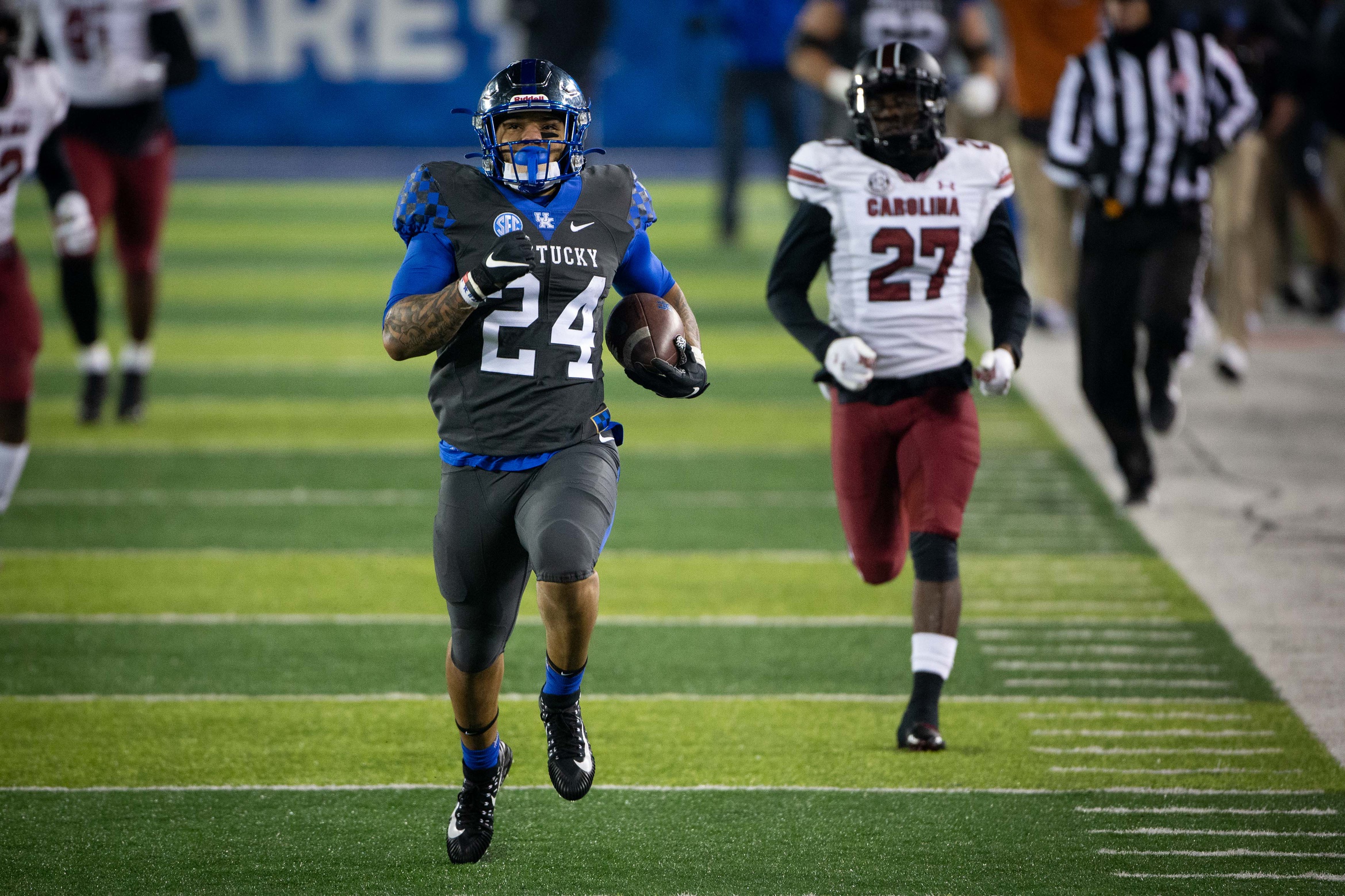
Dec 5, 2020; Lexington, Kentucky, USA; Kentucky Wildcats running back Chris Rodriguez Jr. (24) runs the ball down the field to the end zone during the fourth quarter against the South Carolina Gamecocks at Kroger Field. Credit: Arden Barnes-USA TODAY Sports -
RB Chris Rodriguez, Kentucky
Rodriguez came in as the second-highest-graded running back of the 2020 season with a 92.4 PFF grade. He finished behind only Javonte Williams of UNC among Power 5 backs in percentage of runs to pick up a first down or touchdown at 41%. When it came to those inside zone runs that Kentucky loves so much, Rodriguez jumped to first in rushing grade.
-
RB Khalil Herbert, Virginia Tech
After a middling four-year career at Kansas, Herbert finally had the benefit of a good offensive line in front of him and broke out with the Hokies in 2020. He finished the year with a 91.3 rushing grade and made some big plays fighting through contact. Among backs with at least 100 carries, Herbert tied for first in yards after contact per attempt (4.74) and ranked second in total runs of 20-plus yards with 16.
-
DI Milton Williams, Louisiana Tech
Outside of LA Tech’s Week 5 affair against BYU and one of the best offensive lines in the country, Williams made a big dent in every game played. He finished the year with a grade above 85.0 as both a run-defender and pass-rusher, something only he accomplished among all interior defensive linemen. Specifically in the pass rush, Williams won on over 22% of his reps. Not only did that lead the position, but it led the group handily by 2 percentage points.
-
EDGE Isaiah Thomas, Oklahoma
Thomas played more defensive tackle than any other position, but we have him listed here as an edge rusher because that’s where he was most dominant. The 6-foot-5, 267-pound Sooner racked up pressures on the edge all year long. He recorded a 21.9% pressure rate when playing on the edge, ranking third at the position.
-
EDGE Ronnie Perkins, Oklahoma
Perkins is a small sample darling with just over 260 snaps in six games this past season, but he was absolutely dominant in each of those six outings. The Oklahoma edge rusher earned an elite grade above 90.0 both against the run and in the pass-rush to finish with a PFF overall grade of 90.5. And that was anchored by one of the best games we saw at the position this year back in Week 10 against Kansas when Perkins posted a 98.0 PFF grade.
-
RB Jerrion Ealy, Ole Miss
A 2019 four-star recruit, Ealy never had a game with a monstrous box score, but he consistently showed up and got the job done. He was the sixth-highest-graded runner in the Power 5 at 90.0 and had the second-most carries without a fumble in the country (147). He also showed off the same elusiveness, athleticism and physical play style that we saw on a limited basis as a true freshman in 2019. Ealy owns two of the 15 highest single-game broken tackle rates from the 2020 season and ranked eighth in the Power 5 in percentage of runs to pick up at least 3.0 yards after contact (48%).
-
RB Jaret Patterson, Buffalo
Patterson had one of the best offensive lines in the country in front of him, but that doesn’t mean his production is solely because of his blockers. Among all FBS running backs with at least 75 carries, Patterson ranked eighth in broken tackles per attempt (0.32) and sixth in yards after contact per attempt (4.7). That balance paired with his speed makes him the ideal college scatback. Patterson racked up seven rushing touchdowns in which he had over 10 yards after contact, which led the entire FBS. And keep in mind, he did that in just six games.
-
T Jake Fuzak, Buffalo
Fuzak was among the surprise performers at tackle this season. The fifth-year senior entered the 2020 season with just 164 snaps under his belt but was nothing but dominant from the right tackle spot. Across 168 pass-block snaps in seven games, Fuzak allowed just one total pressure, which was a hurry — not a sack or hit. Fuzak also hardly lost a rep in the run game, as he ranked fourth among all right tackles in negatively graded run-block rate.
-
T Kayode Awosika, Buffalo
Like his teammate Jake Fuzak, Awosika was one of a handful of tackles to finish the 2020 season with an elite PFF grade above 90.0. Awosika also allowed just one total pressure on the year and was a huge asset in the run game. Among all FBS left tackles, Awosika racked up the third-most big-time blocks with 12.
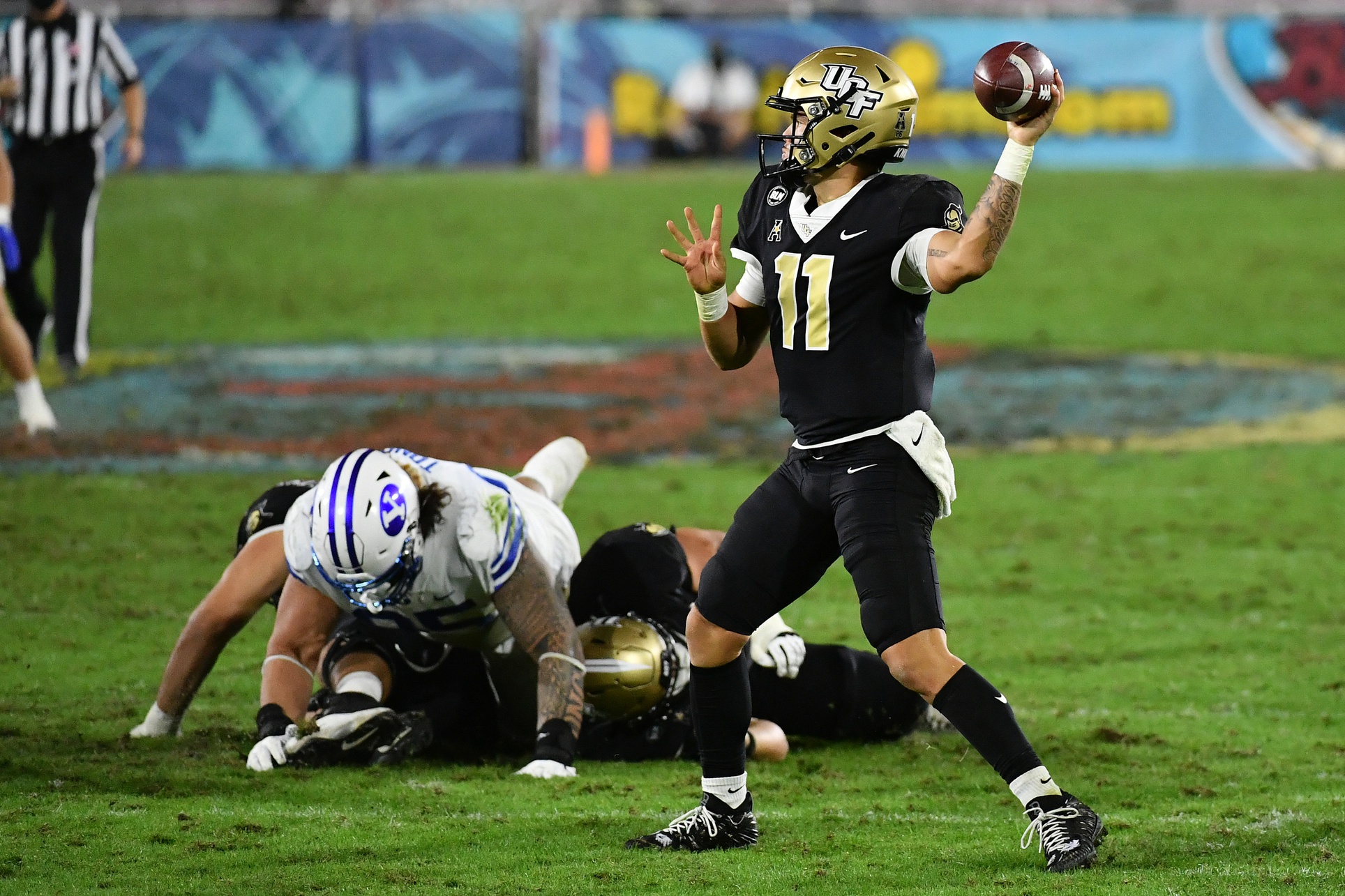
Dec 22, 2020; Boca Raton, Florida, USA; UCF Knights quarterback Dillon Gabriel (11) attempts a pass against the Brigham Young Cougars during the first half at FAU Stadium. Credit: Jasen Vinlove-USA TODAY Sports -
QB Dillon Gabriel, UCF
Gabriel came in at No. 5 among all FBS quarterbacks in PFF Wins Above Average (WAA) and displayed one of the top downfield arms in the country, just like he did as a true freshman in 2019. This UCF offense is chock full of go balls, and Gabriel hit a lot of them. He trailed only Mac Jones in total passing yards coming from throws over 20 yards downfield with 1,338. The potent downfield passing attack resulted in a 90.9 PFF grade for the season, ranking ninth in the FBS.
-
T Dylan Parham, Memphis
Parham moved over to right tackle after spending his first two years on the field at guard and took his play to new heights. He raised his PFF grade of 70.5 in 2019 to 90.6 in 2020 — that ranked ninth among all FBS tackles. When it came to pass protection, there wasn’t a better right tackle in the country in terms of pass-block grade. Parham put up an 87.6 mark in that facet.
-
EDGE Tarron Jackson, Coastal Carolina
Jackson was among the elite pass-rushers in the 2019 season (90.7 pass-rush grade) and maintained that in 2020 (90.3 pass-rush grade). This time around, though, he was also far more effective against the run. This raised his 2019 PFF grade of 84.0 to 90.0 this season. Jackson rushed the passer 86 times more than any other edge rusher in the country, yet he still managed to post a 21% pass-rush win rate (11th in FBS).
-
CB Asante Samuel Jr., Florida State
No cornerback owned a higher coverage grade in the ACC this season than Samuel Jr. (82.8). He had been a bit boom-or-bust at times in the past, but this year it was mostly boom as he generated more plays on the ball (nine) than first downs allowed (eight). Samuel’s size caused him some trouble in coverage, but he made up for it with his athleticism and routinely forced tight coverage in man.
-
LB Edefuan Ulofoshio, Washington
Yes, Ulofoshio only played in four games due to COVID-19’s impact on Washington, but the off-ball linebacker was uber-productive in all four and has shown to be the real deal. Ulofoshio flashed a mini-breakout in 2019 across 217 snaps by shining in every single facet of play, and he did the same thing in 2020 across 235 snaps. He earned a grade above 74.0 in coverage, against the run, as a blitzer and with his tackling. Ulofoshio showed a nose for the football with an incredible 15 defensive stops in those four games, and he also missed just three of his 54 tackle attempts.
-
G Ryan Neuzil, App State
App State’s stout offensive line was anchored by left guard Ryan Neuzil, who was one of the best all-around guards in the country. Neuzil was one of two guards in the FBS to record a grade above 86.0 as both a pass- and run-blocker. Wide zone is App State’s bread and butter, and Neuzil constantly was doing his job to the best of his abilities on those plays. He generated more positively graded run blocks on outside zone runs than any guard in college football by a massive amount.
-
T Larry Borom, Missouri
Borom had an underappreciated breakout year at tackle for Mizzou this season. He recorded a 61.5 PFF grade in 2019 playing mostly right tackle while seeing snaps at left tackle and both guard spots. This year he posted an 87.0 PFF grade, the second-best by an SEC tackle and eighth-best among the Power 5. Borom allowed just four pressures on the year, leading to the second-lowest pressure rate allowed in the Power 5. And that included a big fat zero pressure allowed to the Alabama Crimson Tide.
-
G JACOB GALL, BUFFALO
After a couple of years of serving as a key reserve with just a handful of starts, Gall earned a starting spot this year and made the most of it with an elite PFF grade of 90.5. Buffalo didn’t throw the ball a lot, but when they did, Gall’s pass-protection was nothing short of exceptional. He earned an 86.9 grade as a pass-blocker featuring just two pressures allowed. As a run-blocker, Gall earned an 89.4 grade.
-
TE Isaiah Likely, Coastal Carolina
Likely joins Kyle Pitts as the only tight ends to earn a spot on the PFF College 101 after posting a 92.3 receiving grade this past season. The Chanticleer is a hard man to beat in contested scenarios, as he caught 12 of 17 such targets this season. He was also one of the best tight ends after the catch in 2020 with 10 broken tackles and averaged seven yards after the catch on his 30 receptions.
-
CB Roger McCreary, Auburn
McCreary played the ninth-most coverage snaps in the country in press coverage and still managed a top-10 PFF grade among Power 5 corners. He allowed one catch or less in exactly half of his 10 games played and allowed under 25 yards in coverage in seven. The production didn’t stop there — McCreary also had three interceptions, five forced incompletions and six passing stops.
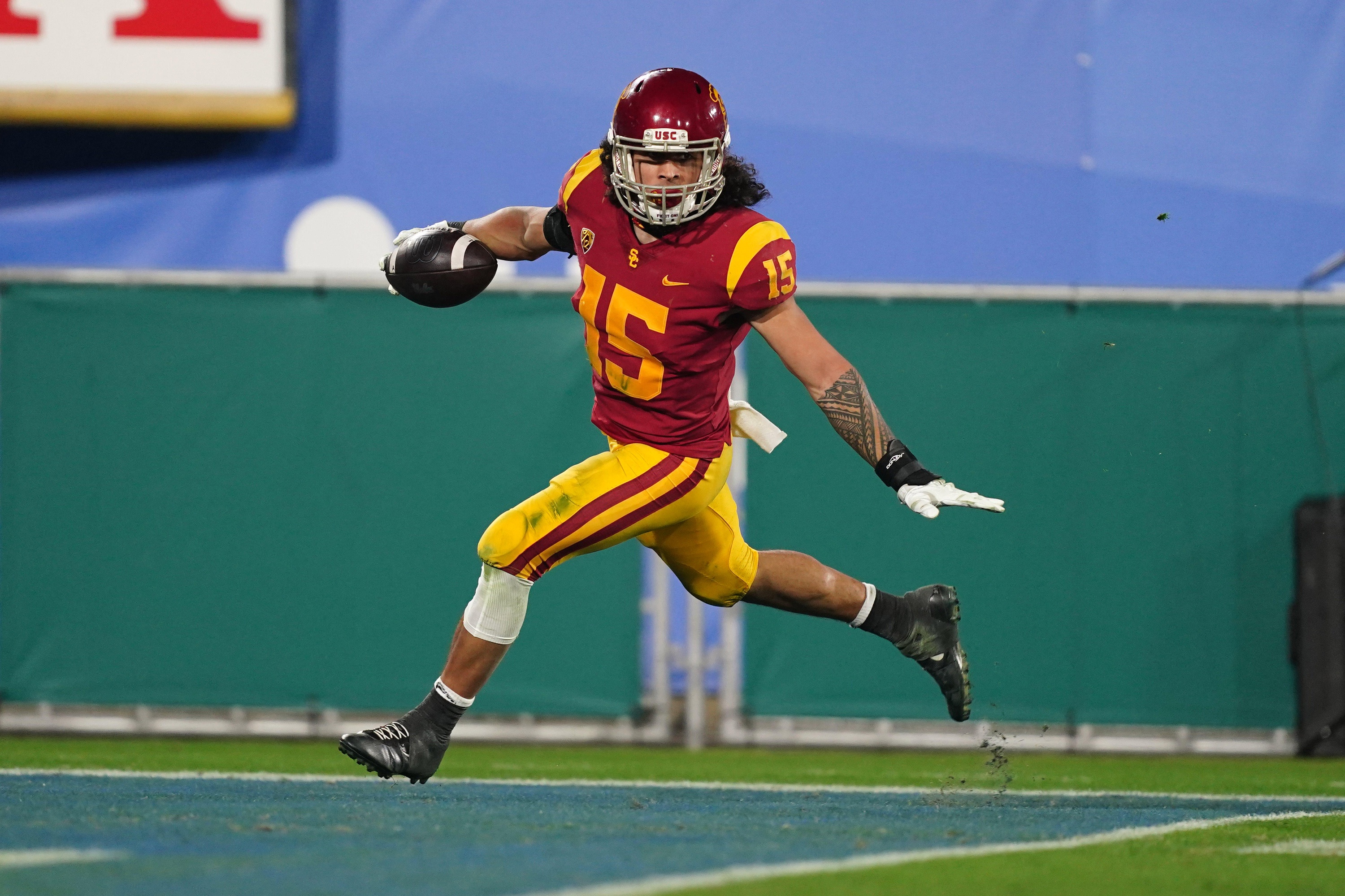
Dec 12, 2020; Pasadena, California, USA; Southern California Trojans safety Talanoa Hufanga (15) celebrates after an interception in the fourth quarter against the UCLA Bruins at Rose Bowl. USC defeated UCLA 43-38. Credit: Kirby Lee-USA TODAY Sports -
S Talanoa Hufanga, USC
Hufanga has been a boom-or-bust player at times this season, but the number of high-end plays we have seen the safety make in six games is incredible. The USC Trojan intercepted four passes, broke up two more, forced two fumbles and produced an 83.2 coverage grade (fifth-best in the FBS).
-
S Bralen Trahan, Louisiana
There were a lot of playmakers in the Ragin’ Cajuns' secondary this season, but none more active than Trahan. He was a huge asset at free safety this year, where he came up with the third-most plays on the ball in the FBS (seven) and the second-best PFF grade. Regardless of where he was on the field, Trahan notched four interceptions and seven pass breakups.
-
T Jack Snyder, San Jose State
Snyder — a fifth-year senior — came into the season with three years of starting experience under his belt and showed nice growth each year by boosting his PFF grade from 64.7 to 71.2 to 77.0. This season, the improvement he made wasn’t nearly as subtle. Snyder’s PFF grade this year jumped all the way to 90.9, the eighth-best in college football.
-
C MIKE NOVITSKY, BUFFALO
Continuing the trend of standout Buffalo offensive linemen is center Mike Novitsky, who was the highest Group of 5 center by a substantial margin. He recorded an 88.3 PFF grade on the year, over nine grading points higher than any other non-Power 5 center. Novitsky did earn the honorable mention spot on the PFF All-American team, but slid a bit among all FBS centers with a so-so performance against Marshall in the Camellia Bowl (56.1 PFF grade, worst of season).
-
WR Marvin Mims, Oklahoma
Mims wasn’t the first, second or even third option in this Oklahoma offense this year. The true freshman ranked fourth on his team in total routes run but was by far the most productive Sooner and one of the most productive in the entire FBS. His 89.1 receiving grade and 4.07 yards per route run each were among the 10 best marks at the position this season.
-
WR Jonathan Adams Jr., Ark State
Adams is far from a separator, but that doesn’t matter with how often the 6-foot-3, 220-pound wide receiver bodies his defender in tight coverage. He led all FBS wide receivers in receiving grade on contested targets and caught a whopping 23 contested catches, seven more than any other FBS wide receiver.
-
EDGE Myjai Sanders, Cincinnati
Week in and week out, Sanders showed up and made an impact for the Bearcats. He recorded at least three pressures in every single game played along with a 22.9% win rate for the season (tied for seventh). Sanders also got his mits on five different passes to result in a batted ball. This all led to a 90.1 pass-rush grade in 2020.
-
WR Treylon Burks, Arkansas
With his size, physicality and speed, Burks is an absolute monster after the catch. The 6-foot-3, 232-pound receiver averaged 7.6 yards after catch per reception and broke nine tackles on 50 receptions. That comes in handy on underneath concepts, but those traits are best utilized with the deep ball. Burks saw 12 deep targets this year and hauled in eight. He had open separation (more than a couple of steps) on six of those, and four went for a touchdown (tied for second-most in FBS).
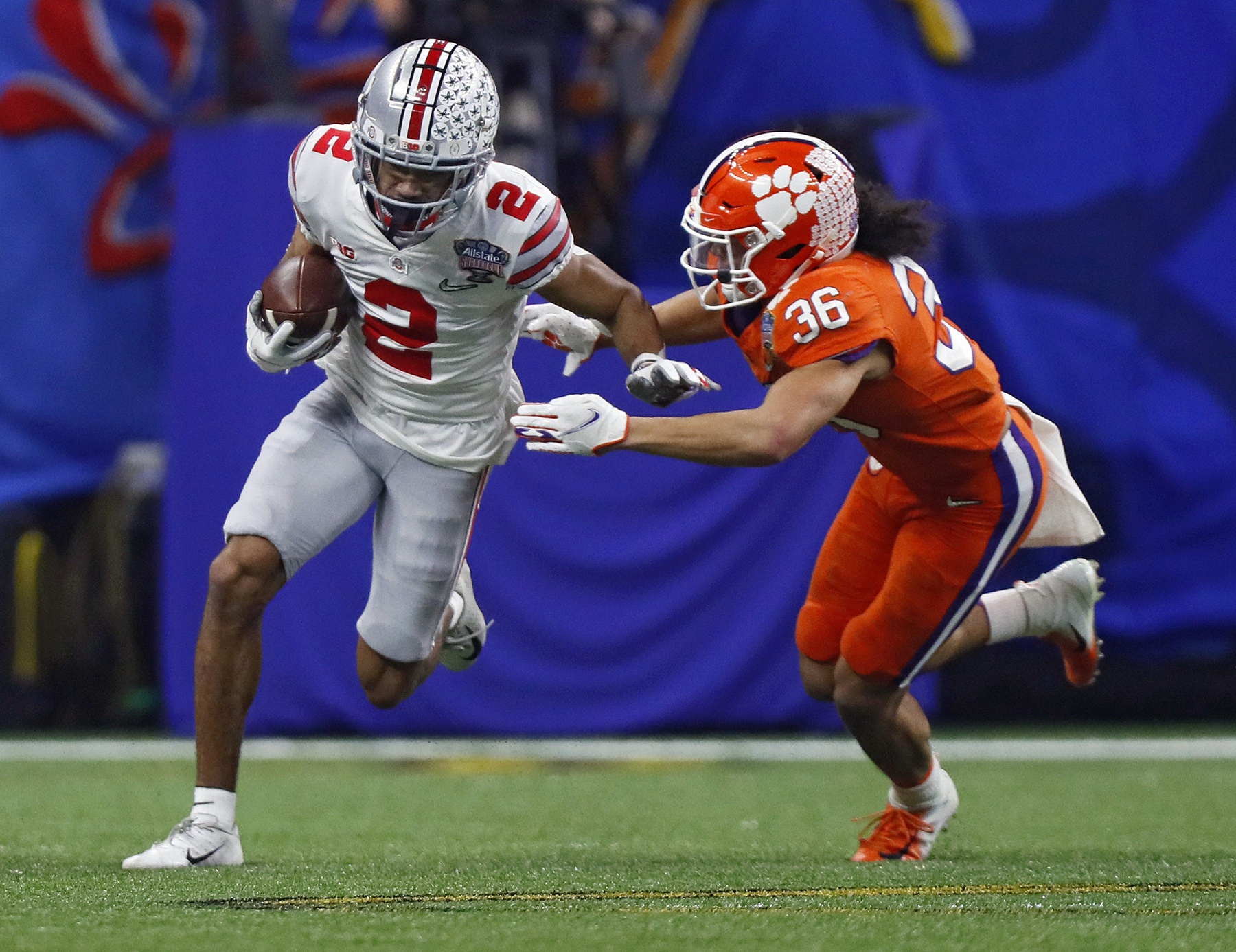
Ohio State Buckeyes wide receiver Chris Olave (2) heads upfield after a catch against Clemson Tigers safety Lannden Zanders (36) in the second quarter during the College Football Playoff semifinal. Credit: Imagn -
WR Chris Olave, Ohio State
Olave is in the top-tier of college football when it comes to route-running. The Ohio State Buckeye got open at the sixth-highest rate in the country in 2020. Among all Power 5 wide receivers this season against single coverage, Olave ranks sixth in receiving grade and first in passer rating when targeted — a near-perfect 157.5 mark with 13 receptions on 17 such targets for 242 yards and five touchdowns.
-
EDGE Jonathon Cooper, Ohio State
After an injury-riddled senior campaign in 2019 that forced him to redshirt, Cooper has put together a rare fifth-year breakout this season. Cooper was a four-star recruit who ranked 57th nationally in the 2016 ESPN 300, but he hadn't lived up to expectation, mustering a four-year pass-rush grade of 71.2. This season, he broke out with a 90.5 pass-rush grade — the sixth-best in the FBS — and 20.6% pass-rush win rate.
-
CB Jaycee Horn, South Carolina
Horn plays bully ball. He is sometimes a bit too physical, but it often helps him shut down his opponent. The 6-foot-1, 205-pound corner is physical at the line of scrimmage and hardly gave up a catch this season. Across seven games this season, Horn allowed just eight catches while making nine plays on the ball on 24 targets. No corner in the entire FBS played more coverage snaps per catch allowed than Horn (27.4 snaps per catch).
-
Ahmad Gardner, Cincinnati
Gardner has put together quite the college resume over the past two years as an underclassman. He ranked seventh among FBS cornerbacks as a true freshman in PFF grade last year and came back in 2020 as the same playmaker. The Bearcat allowed the second-lowest passer rating in the FBS in coverage this year (29.3), making more plays on the ball (12) than first downs allowed (eight). He has now made over 30 plays on the ball without giving up a touchdown in his college career.
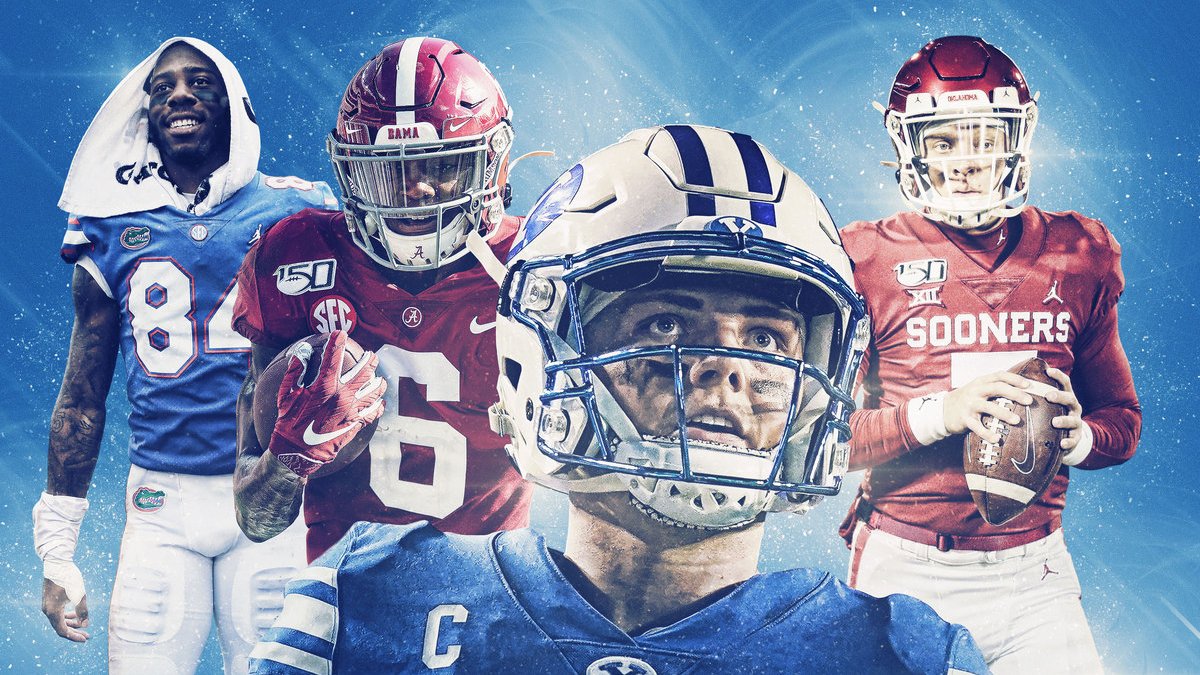



 © 2025 PFF - all rights reserved.
© 2025 PFF - all rights reserved.